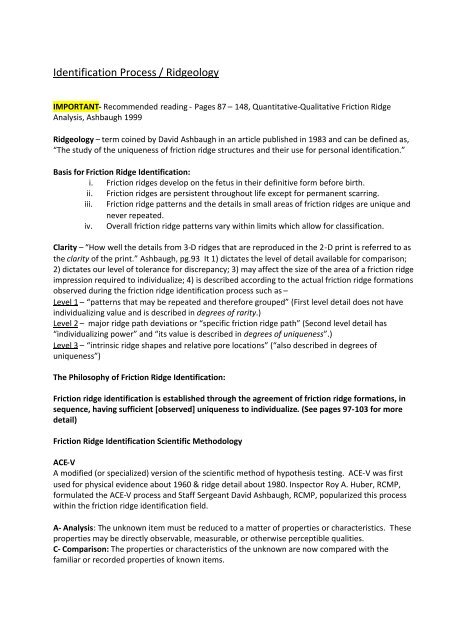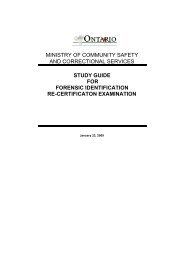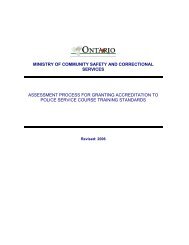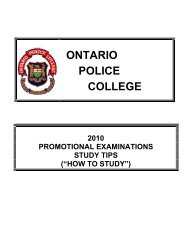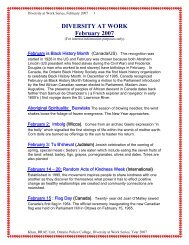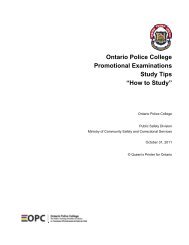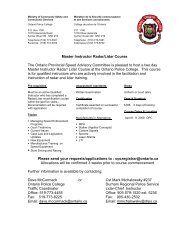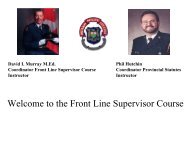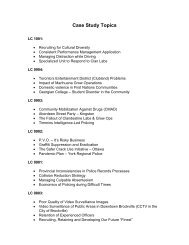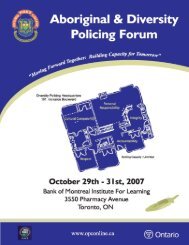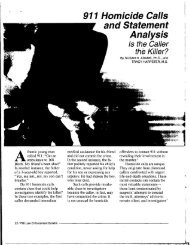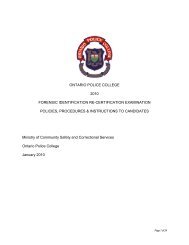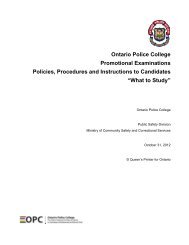General Study Guide - Ontario Police College
General Study Guide - Ontario Police College
General Study Guide - Ontario Police College
You also want an ePaper? Increase the reach of your titles
YUMPU automatically turns print PDFs into web optimized ePapers that Google loves.
Identification Process / Ridgeology<br />
IMPORTANT- Recommended reading - Pages 87 – 148, Quantitative-Qualitative Friction Ridge<br />
Analysis, Ashbaugh 1999<br />
Ridgeology – term coined by David Ashbaugh in an article published in 1983 and can be defined as,<br />
“The study of the uniqueness of friction ridge structures and their use for personal identification.”<br />
Basis for Friction Ridge Identification:<br />
i. Friction ridges develop on the fetus in their definitive form before birth.<br />
ii. Friction ridges are persistent throughout life except for permanent scarring.<br />
iii. Friction ridge patterns and the details in small areas of friction ridges are unique and<br />
never repeated.<br />
iv. Overall friction ridge patterns vary within limits which allow for classification.<br />
Clarity – “How well the details from 3-D ridges that are reproduced in the 2-D print is referred to as<br />
the clarity of the print.” Ashbaugh, pg.93 It 1) dictates the level of detail available for comparison;<br />
2) dictates our level of tolerance for discrepancy; 3) may affect the size of the area of a friction ridge<br />
impression required to individualize; 4) is described according to the actual friction ridge formations<br />
observed during the friction ridge identification process such as –<br />
Level 1 – “patterns that may be repeated and therefore grouped” (First level detail does not have<br />
individualizing value and is described in degrees of rarity.)<br />
Level 2 – major ridge path deviations or “specific friction ridge path” (Second level detail has<br />
“individualizing power” and “its value is described in degrees of uniqueness”.)<br />
Level 3 – “intrinsic ridge shapes and relative pore locations” (“also described in degrees of<br />
uniqueness”)<br />
The Philosophy of Friction Ridge Identification:<br />
Friction ridge identification is established through the agreement of friction ridge formations, in<br />
sequence, having sufficient [observed] uniqueness to individualize. (See pages 97-103 for more<br />
detail)<br />
Friction Ridge Identification Scientific Methodology<br />
ACE-V<br />
A modified (or specialized) version of the scientific method of hypothesis testing. ACE-V was first<br />
used for physical evidence about 1960 & ridge detail about 1980. Inspector Roy A. Huber, RCMP,<br />
formulated the ACE-V process and Staff Sergeant David Ashbaugh, RCMP, popularized this process<br />
within the friction ridge identification field.<br />
A- Analysis: The unknown item must be reduced to a matter of properties or characteristics. These<br />
properties may be directly observable, measurable, or otherwise perceptible qualities.<br />
C- Comparison: The properties or characteristics of the unknown are now compared with the<br />
familiar or recorded properties of known items.


